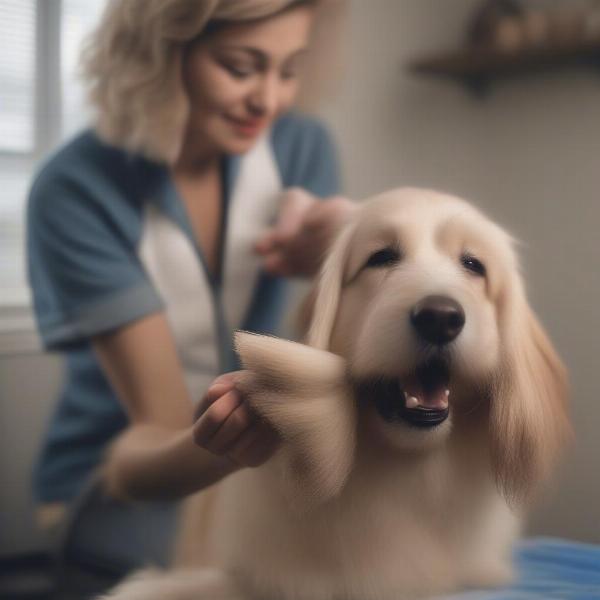A ticking dog coat is a unique and eye-catching pattern characterized by small, distinct flecks of color on individual hairs. This pattern creates a mottled or speckled appearance, often resembling tiny ticks, hence the name. Understanding this coat type, its genetics, and the breeds that commonly exhibit it can help you appreciate its distinct beauty.
What Causes a Ticking Dog Coat?
The ticking pattern is a result of the Agouti gene, which controls the distribution of pigment along each hair shaft. This gene causes the hair to alternate between bands of color, typically a lighter base color and a darker tip, creating the characteristic ticked appearance. This pattern is often seen alongside other markings like roaning or patching, adding further complexity and intrigue to the dog’s coat. The intensity of the ticking can vary significantly between breeds and even individual dogs, ranging from subtle speckles to a dense, almost solid appearance.
Breeds Commonly Exhibiting the Ticking Pattern
Several breeds are known for their ticking coats. Some prominent examples include:
- Bluetick Coonhound: As their name suggests, these hounds are known for their distinctive blue ticking, often interspersed with black and tan markings.
- American Foxhound: Similar to the Bluetick Coonhound, American Foxhounds can also exhibit ticking, though their coat color can vary more widely.
- English Setter: These elegant sporting dogs often display a beautiful ticking pattern, commonly referred to as “belton” markings, which can range from orange and white to blue and white.
- German Short-haired Pointer: These versatile hunting dogs are another breed where ticking is frequently seen, often combined with liver or black patches.
Is a Ticking Coat Prone to any Specific Health Concerns?
The ticking pattern itself isn’t directly linked to any specific health issues. However, certain breeds that frequently exhibit ticking, like Dalmatians (which have a similar spotting pattern though not strictly ticking), can be prone to deafness. It’s crucial to research breed-specific health concerns when considering a dog with a ticking coat.
Grooming a Dog with a Ticking Coat
Grooming requirements for a ticking coat are generally straightforward. Regular brushing helps remove dead hair and distribute natural oils, keeping the coat healthy and shiny.  Brushing a dog with a ticking coat Bathing should be done as needed, using a gentle dog shampoo. Remember to check for ticks and other parasites, especially if your dog spends time outdoors in wooded or grassy areas, as the ticking pattern can sometimes make these pests harder to spot.
Brushing a dog with a ticking coat Bathing should be done as needed, using a gentle dog shampoo. Remember to check for ticks and other parasites, especially if your dog spends time outdoors in wooded or grassy areas, as the ticking pattern can sometimes make these pests harder to spot.
Conclusion
The ticking dog coat is a fascinating genetic trait, resulting in a striking and unique appearance. While the ticking pattern itself doesn’t indicate any health concerns, understanding the specific breed’s predisposition to certain health conditions is crucial. With proper care and grooming, a dog with a ticking coat will remain a beautiful and healthy companion for years to come.
FAQ
- What gene causes the ticking pattern? The Agouti gene is responsible for the ticking pattern.
- Is ticking the same as roaning? No, ticking refers to distinct flecks of color, while roaning is a more even mixture of colored and white hairs.
- Are all ticking coats the same color? No, ticking can appear in various colors, including blue, liver, black, and orange.
- Do dogs with ticking coats need special grooming? Not necessarily, but regular brushing is recommended.
- Are there health issues associated with a ticking coat? The ticking pattern itself isn’t linked to health issues, but certain breeds with ticking coats can have breed-specific health concerns.
- How can I find a reputable breeder for a dog with a ticking coat? Research breed-specific rescue organizations and reputable breeders who prioritize health testing.
- What is the difference between ticking and spotting? Ticking refers to small flecks of color on individual hairs, while spotting refers to larger patches of different colors.
Related Articles
ILM Dog is a leading international online resource for dog owners and enthusiasts, dedicated to providing expert advice on all aspects of dog care, from breed selection to health, training, nutrition, grooming, and more. Whether you’re a seasoned dog owner or just starting your journey, ILM Dog offers a wealth of information to help you provide the best possible care for your canine companion. Contact us at [email protected] or +44 20-3965-8624. Learn more about us at ILM Dog.